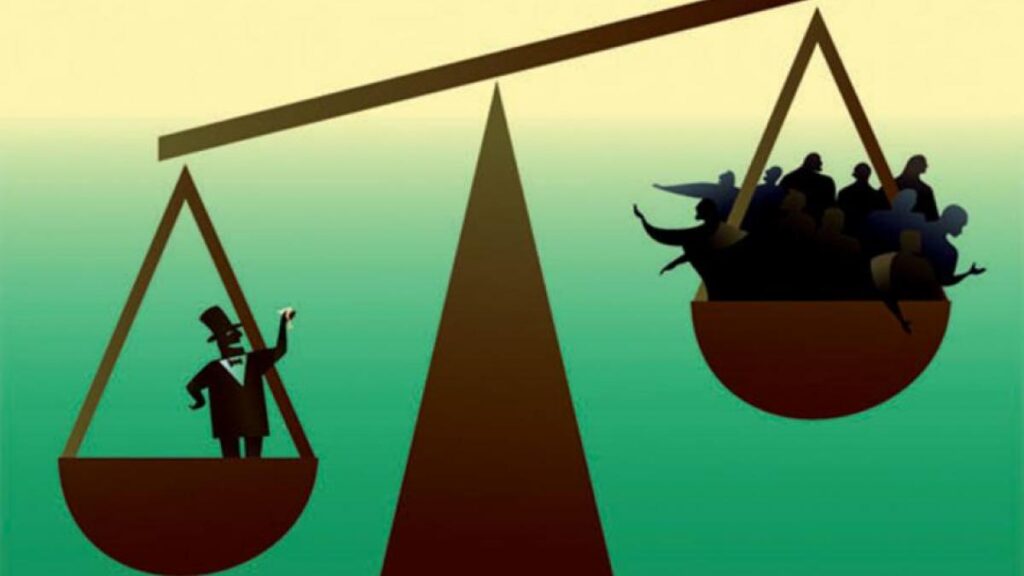The World Inequality Report (WIR) is widely regarded as a highly credible and comprehensive report on the extent of inequalities in world. The latest WIR for year 2022 has been released very recently. It has been authored by Lucas Chancel, co-director of the World Inequality Lab, with other coordinators, including France’s Thomas Piketty, and presents a damning indictment of the very high level of inequalities in India. As presented in WIR, the levels of wealth and income inequalities in India are among the worst that prevail in the leading countries of the world.
These statistics for wealth inequality tell us that the share of the bottom 50% of the households in wealth is just 6% in India. At the same time the share of the top 10% in wealth is 65% in India, a very high figure indeed. What is perhaps even more shocking is that the share of the top 1 per cent in wealth is a whopping 33%.
The average household wealth in India is equal to 35,000 Euro or Rs 983,010, as per the data shared by the World Inequality Lab. The bottom 50% own almost nothing, with an average wealth of 4,200 Euro or Rs 66,280. The middle class is relatively poor, with an average wealth of only 26,400 Euro or Rs 723,930, the report said. This constitutes 29.5% of the total wealth. The top 10% of the population have an average wealth at 231,300 Euros or Rs 6,354,070.
Coming now to income inequality the share of the bottom 50% in income is just 13% in India. On the other hand the share of the top 10% in income is 57% and the share of just the top 1% is as high as 22%.
As per the report, the average national income of the Indian adult population is 7,400 Euro or Rs 204,200. While the bottom 50% earns 2,000 Euro or Rs 53,610, the top 10% earns more than 20 times more (42,500 Euro or Rs 1,166,520).
Here it should be pointed out that the overall income levels in India are lower than in many other countries which have high inequality. Here the impact of inequality is likely to be seen much more in terms of denial of basic needs. For this reason, although reduction of inequality is needed everywhere, it is needed much more in countries like India where its impact in terms of denial of basic needs is much higher.
WIR has also drawn attention to the shameful reality that the inequality levels in India are returning to the very high levels seen in colonial times. The report notes, “Indian income inequality was very high under British colonial rule (1858-1947), with a top 10% income share around 50%. After independence, socialist-inspired five-year plans contributed to reducing this share to 35-40%. Since the mid-1980s, deregulation and liberalisation policies have led to one of the most extreme increases in income and wealth inequality observed in the world. While the top 1% has largely benefited from economic reforms, growth among low and middle-income groups has been relatively slow and poverty persists.”
It is really a very shameful reflection on the development and economic priorities followed by the ruling regimes that inequalities are now returning almost to the situation existing in colonial times.
Gender and Carbon Inequality
“Gender inequalities in India are very high. The female labour income share is equal to 18%. This is significantly lower than the average in Asia (21%, excluding China),” the report stated. This particular value in India is one of the lowest in the world and only just higher than the average share in the Middle East, where the share of females in national income is at 15%.
With regards to carbon emission, the report notes that the average person in the “bottom 50% of the Indian population is responsible for, on average, five times fewer emissions than the average person in the bottom 50% in the European Union and ten times fewer than the average person in the bottom 50% in the US.”
“India is a low carbon emitter: the average per capita consumption of greenhouse gas is equal to just over two tCO2e. These levels are typically comparable with carbon footprints in sub-Saharan African countries. The bottom 50%, middle 40% and top 10% respectively consume 1, 2, and 9 tCO2e/capita,” the report further notes.
Quality of Data Deteriorating
Lastly, the WIR has also noted that the quality of data needed to monitor inequalities has deteriorated in recent times. Earlier India used to be known to have some of the best statistical systems among developing countries. So the new strategy of the ruling classes appears to be to reduce access to the kind of information that can reveal the increasing inequalities, exploitation and injustices in India. It is really sad and tragic that so many freedom fighters made the greatest sacrifices for the freedom of India, but as we move towards the 75 years of independence the inequality levels are going back to the years of colonial times. Surely something needs to be done to change this shameful reality.
(Compiled by us based on an article by Bharat Dogra and an article in Newsclick.)




